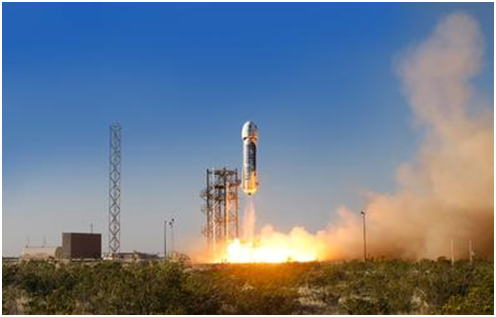Blue Origins Successfully Launches and Softly Lands Rocket
It is expensive to launch a satellite or spacecraft. One of the biggest expenses is the one-time use of the engine and the fuel tanks. A number of different solutions have be attempted and are being researched to deal with this. Ideally, the launch vehicle should return to Earth and land gently so it can be reused. This would significantly reduce launch costs.
Recently, SpaceX, the private space company founded by Elon Musk, has attempted to fly their Falcon 9 launch vehicle back to the launch pad and bring it down for a safe landing. The Falcon is used to lift a satellite into orbit. In order to do this, it must achieve a speed of about seven thousand six hundred miles per hour before detaching from the satellite fifty miles up. Momentum carries it to apogee or maximum altitude of ninety miles before it begins to fall back to Earth. Descending from this altitude for a soft landing has proven difficult. Several tests have failed but SpaceX is working on the problems and should achieve its goal soon.
Blue Origins is a private space firm founded by Jeff Bezos in direct competition to Elon Musk's SpaceX. It recently conducted a test of its New Shepherd space vehicle consisting of a BE-3 rocket and a crew capsule. During the test, the BE-3 carried the crew capsule to a suborbital altitude of about sixty miles. Then the B-3 detached at a fifty-mile altitude and came back to Earth for a successful soft landing. This landing was easier than the landing for the Falcon 9 because the B-3 rocket only reached a top speed of about two thousand eight hundred miles per hour, considerably less than the Falcon 9. It fell from a lower apogee of sixty miles and fired its rockets at about 5,000 feet to come in for a soft landing. It survived a two hundred mile an hour cross wind at high altitude and managed to land within four feet of the targeted position.
Bezos intends to use the New Shepherd and the B-3 rocket for suborbital tourist flights. The system is intended to carry the crew capsule with up to six astronauts to an altitude of about sixty-two miles which is considered to be the "edge of space."
Virgin Galactic, the company founded by Richard Branson, is also in this race. Their spacecraft, SpaceShip 2, launched from an airplane, recently crashed during a test, taking the life of one pilot. Technical problems caused the craft to disintegrate.
Paul Allen, another billionaire, is also involved in private space flight with the United Launch Alliance. They may use the Blue Origin B-3 rocket as the second stage of their Vulcan orbital rocket.
A much smaller company, XCOR, in the Mojave Desert of California also has a horse in this race. Their Lynx space plane can take off from a runway and go straight up sixty miles to the edge of space. It burns kerosene and hydrogen peroxide. It can carry two or one person and an instrumentation package. A cowling can be attached to the roof to carry a payload like a small rocket and microsatellite that can reach a higher orbit.
The race is on and billions of dollars are being spent to develop a reusable space launch vehicle that can drop the launch price and really open up the exploration and exploitation of space.
Blue Origins New Shepherd:
